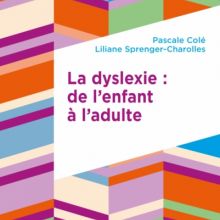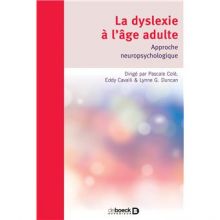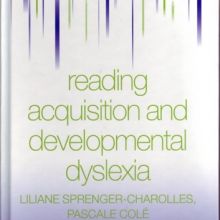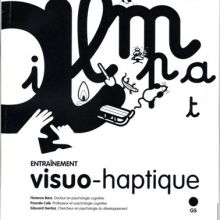COLE Pascale
Onglets principaux

Equipe(s) de recherche
Fonctions
Full Professor (Cognitive Psychology), Classe exceptionnelle
Chevalier of the National Order of Merit
Language team leader
Editor-in-Chief of the bilingual journal L’Année Psychologique / Topics in Cognitive Psychology
Domaines de recherche
My research currently focuses on dyslexic university students (who are few in number: 1.6% of the student population): specifically, on the cognitive compensation and the protective factors they have developed allowing them to pursue postsecondary studies despite persistent reading deficits (written word recognition). One hypothesis currently under investigation with collaborators is that reading of dyslexic students, who have been systematically found to have an impaired phonological reading route, is supported by the morphological processing of written words (identifying their component morphemes: e.g., chaton = chat + on; Martin, Frauenfelder & Colé, 2013; Cavalli..& Colé, 2016). Our recent work with EEG (Beyersman, Iakimova, Ziegler & Colé, 2014) and MEG in collaboration with Johannes Ziegler has shown that in normal adult readers, the morphological route activates a highly distributed spatial circuit (Journal of Cognitive Neurosciences, 2016). In dyslexic university students, this cerebral circuit greatly differs both spatially and temporally; in particular, frontal and orbitofrontal areas (which are involved in the semantic processing of morphemes and in cognitive control) are activated earlier (Cortex, 2017).
My research extends to reading acquisition, both in normal and pathological populations (developmental dyslexia and deafness with cochlear implant). The research has mainly focused on morphological processing and knowledge leading to numerous international publications (see selected publications below). It has also led to the creation and distribution of tools for the diagnosis of dyslexia (EVALEC, 2010) and the remediation of dyslexia (Morpho-Rem, 2012). Further, we have developed aids for use in classroom reading (visuo-haptic method for children in kindergarten and a reading acquisition manual for children in 1st and 2nd grade).
Articles in peer-reviewed journals
- Lapeyre, E., Melmi, J.B., Colé, P. & Calabrèse, A. (accepted). Pulsed Lighting for Adults with Dyslexia: Very Limited Impact, Confined to Individuals with Severe Reading Deficits, Scientific Reports.
- Cavalli, E., Brèthes, H., Lefèvre, E., El Ahmadi, A., Duncan, L.G., Bianco, M., Melmi, J.B., Denis-Noël, A. & Colé, P. (accepted). Screening for dyslexia in university students: An optimal and efficient standardized procedure based on conditional inference trees. Archives of Clinical Neuropsychology, 00, 1-18. https://doi.org/10.1093/arclin/acad103
- Denis-Noël, A., Colé, P., Bolger, D., Chotiga Pattamadilok, C. (2023). How do adults with dyslexia recognize spoken words? Evidence from behavioral and EEG data. Scientific Studies of Reading.1-21.
- Marchetti, R., Pinto, S., Spieser, M., Vaugoyeau, M., Cavalli, E., El Ahmadi, A. Assaiante, C. & Colé, P. (2023). Phoneme representation and articulatory impairment: Insights from adults with comorbid motor coordination disorder and dyslexia. Brain Sciences, 13(2), 210.
- Lefèvre, E., Cavalli, E., Colé, P., Law, J.M. & Sprenger-Charolles, L. (2023). Tracking Reading and Related Skills in Adolescents with Dyslexia Before (age 5) and After (ages 10-17) Diagnosis. Annals of Dyslexia. https://doi.org/10.1007/s11881-022-00277
- Brèthes, H., Cavalli, E., Denis-Noël, A., Melmi, J.B., El Ahmadi, A, Bianco, M., and Colé, P. (2022). Text reading fluency and text reading comprehension do not rely on the same abilities in university students with and without dyslexia. Frontiers in Psychology. https://doi.org/10.3389/fpsyg.2022.866543
- Marchetti, R., Vaugoyeau, M., Colé, P. & Assaiante, C. (2022). A sensorimotor representation impairment in dyslexic adults: A specific profile of comorbidy. Neuropsychologia, 165, https://doi.org/10.1016/j.neuropsychologia.2021.108134 SMASH
- Denis-Noël, A., Pattamadilok, Ch., Castet, E. & Colé, P. (2020). Activation time-course of phonological code in silent word recognition in adult readers with and without dyslexia. Annals of Dyslexia, 70(3), 313-338. doi: 10.1007/s11881-020-00201-1
- Rasamimanana, M., Barbaroux, M., Colé, P. & Besson, M. (2020). Semantic compensation and novel word learning in university students with dyslexia. Neuropsychologia, 139, https://doi.org/10.1016/j.neuropsychologia.2020.107358.
- Cavalli, E., Colé, P., Brèthes, H., Lefevre, E., Lascombe, S., & Velay, J. L. (2019). E-book reading hinders aspects of long-text comprehension for adults with dyslexia. Annals of Dyslexia, 69(2), 243-259.
- Castet, É., Descamps, M., Denis-Noël, A., & Colé, P. (2019). Dyslexia research and the partial report task: A First Step toward Acknowledging Iconic and Visual Short-term Memory. Scientific Studies of Reading, 1-11.
- Gonthier, C., Zira, M., Colé, P. & Blaye, A. (2019). Evidencing the Developmental Shift from Reactive to Proactive Control in Early Childhood, and its Relationship to Working Memory. Journal of Experimental Child Psychology, 117, 1-16. https://doi.org/10.1016/j.jecp.2018.07.001
- Colé, P., Cavalli, E., Duncan, L.G., Theurel, A., Gentaz, E., Sprenger-Charolles, L. & El Ahmadi, A. (2018). What is the influence of morphological knowledge in the early stages of reading acquisition among low SES children? A Graphical modeling approach. Frontiers in Psychology. doi: 10.3389/fpsyg.2018.00547.
- Cavalli, E., Colé, P., Leloup, G., Sprenger-Charolles, L., Poracchia-G, F., & El Ahmadi, A. (2018). Screening for dyslexia in French-speaking university students: an evaluation of the detection accuracy of the Alouette test. Journal of Learning Disabilities. 51, 268-282.
- Castet, E., Descamps, M., Denis-Noël, A., & Colé P. (2017). Letters and symbols identification: no evidence for letter-specific crowding mechanisms. Journal of Vision. 17(11)2, 1-19.
- Cavalli, E., Colé, P., Pattamadilok, C., Badier, J. M., Zielinski, C., Chanoine, V., & Ziegler, J. C. (2017). Spatiotemporal reorganization of the reading network in adult dyslexia. Cortex. 92, 204-221.
- Cavalli, E., Duncan, L. G., Elbro, C., El Ahmadi, A., & Colé, P. (2017). Phonemic-Morphemic dissociation in dyslexic university students: An index of reading compensation? Annals of Dyslexia. 67, 63-84.
- Cavalli, E., Colé, P., Badier, J. M., Zielinski, C., Chanoine, V., & Ziegler, J. C. (2016). Spatio-temporal dynamics of morphological processing in visual word recognition. Journal of Cognitive Neuroscience, 28, 1228-42.
- Pourcin, L. & Colé, P. (2016). L’évaluation cognitive de la lecture au collège: Synthèse des principaux outils de dépistage et de diagnostic des troubles spécifiques de la lecture et cognitifs associés. Psychologie Française. doi : 10.1016/j.psfr.2016.07.001
- Beyersmann, E., Cavalli, E., Casalis, S., & Colé, P. (2016). Embedded stem priming effects in prefixed and suffixed pseudowords. Scientific Studies of Reading, 20:3, 220-230.DOI : 10.1080/10888438.2016.1140769
- Cavalli, E., Casalis,, S., El Ahmadi, A., Zira, M., Poracchia-George, F., & Colé, P. (2016). Vocabulary skills are well developed in university students with dyslexia: Evidence from multiple case studies. Research in Developmental Disabilities, 51-52, 89-102.
- Pourcin, L., Sprenger-Charolles, L., El Ahmadi, A. & Colé, P. (2016). Reading and related skills in grade 6, 7, 8, and 9: French normative data from EVALEC. European Review of Applied Psychology, 66, 23-37.
- Pansu, P., Régner, I., Max, S., Colé, P., Nezlek, J.B., & Huguet, P. (2016). A burden for the boys : Evidence of stereotype threat in boys’ reading performance. Journal of Experimental Social Psychology, 65, 26-30. DOI : 10.1016/j.jesp.2016.02.008
- Bouton, S., Colé, P., Serniclaes, W., Duncan, L.G., & Giraud, A.L. (2015). Atypical phonological processing impairs written word recognition in children with cochlear implants. Language, Cognition & Neuroscience.DOI: 10.1080/23273798.2014.1002796.
- Beyersmann, E., Iakimova, G., Ziegler, J.C. & Colé, P. (2014). Semantic processing during morphological priming: An ERP study. Brain Research, 1579 (4), 45-55. dx.doi.org/10.1016/j.brainres.2014.07.0100006-8993/.
- Colé, P., Duncan, L.G. & Blaye, A. (2014). Cognitive flexibility predicts early reading skills. Frontiers in Psychology:565. doi: 10.3389/fpsyg.2014.00565.
- Pourcin, L., Colé, P. & Sprenger-Charolles, L. (2014). La lecture chez le collégien : bilan des recherches et perspectives. L'Année Psychologique/Topics in Cognitive Psychology, 114(1), 173-205.
- Gentaz, E., Sprenger-Charolles, L., Theurel, A. & Colé, P. (2013). Reading comprehension in a large cohort of French first graders from low socio-economic status families: a 7-month longitudinal study. PlosOne 8(11): e78608.
- Martin, J., Frauenfelder, U. & Colé, P. (2013). Morphological awareness in dyslexic students. Applied Psycholinguistics, 1-21, doi: 10.1017/S0142716413000167.
- Bouton, S., Colé, P., Bertoncini, J., & Serniclaes, W. (2012). Perception of Speech Features by French-Speaking Children With Cochlear . Journal of Speech, Language and Hearing Research, 55, 139-153.
- Bouton, S., Serniclaes, W. & Colé, P., (2012). The influence of lexical knowledge on phoneme discrimination in deaf children with cochlear implants, Journal of Speech Communication, 54, 189-198.
- Colé, P., Bouton, S., Leuwers, C., Casalis, S., & Sprenger-Charolles, L. (2012). Stem and Derivational-Suffix Processing During Reading by French Second and Third Graders. Applied Psycholinguistics, 33, 97-120.
- Bouton, S., Serniclaes, W., Bertoncini, J., & Colé, P. (2011). Reading and reading related skills in children using cochlear implants: Prospects for the influence of Cued Speech. Journal of Deaf Studies and Deaf Education, 16(4), 458-473
- Quémard, P., Casalis, S., & Colé, P. (2011). The role of form and meaning in the processing of written morphology: A priming study in French developing readers. Journal of Experimental Child Psychology, 109, 478-496.
- Hillairet de Boisferon, A. Colé, P. & Gentaz, E. (2010). Connaissance du nom et du son des lettres, habiletés métaphonémiques et capacités de décodage en grande section de maternelle. Psychologie Française, 55, 91-111.
- Martin, J., Colé, P., Leuwers, C., Casalis, S., Zorman, M. & Sprenger-Charolles, L. (2010). Reading in French-speaking adults with dyslexia. Annals of Dyslexia. 60(2), 238-264.
- Casalis, S., Dusautoir, M., Colé, P. & Ducrot, S. (2009). Morphological relationship to children word reading : a priming study in fourth graders. British Journal of Developmental Psychology, 27, 761-766.
- Casalis, S. & Colé, P. (2009). On the relationship between morphological and phonological awareness: Effects of training in kindergarten and in first-grade reading. First Language, 29(1), 113-145.
- Duncan, L., Casalis, S. & Colé, P. (2009). Early meta-linguistic awareness of derivational morphology : Some observations from a comparison of English and French. Applied Psycholinguistics, 30, 405-440.
- Sprenger-Charolles, L., Colé, P., Kipfer-Piquard, A., Pinton, F. & Billard, C. (2009). Reliability and prevalence of an atypical development of phonological skills in French-speaking dyslexics. Reading and Writing, 22(7), 811-842.
- Bara, F., Gentaz, E., Colé, P. (2008). Littératie précoce et apprentissage de la lecture : comparaison entre des enfants à risque, scolarisés en France dans des réseaux d’éducation prioritaire et des enfants de classes régulières. Revue des Sciences de l’Education, 34, 27-45.
- Bara, F., Gentaz, E. & Colé, P. (2007). Haptics in learning to read with children coming from low socio-economic status families, British Journal of Developmental Psychology, 25, 643-663.
- Hillairet de Boisferon, A., Bara, F., Gentaz, E. & Colé, P. (2007). Préparation à la lecture des jeunes enfants : Effets de l’exploration visuo-haptique des lettres et de la perception visuelle des mouvements d’écriture. L’Année Psychologique, 107, 537-564.
- Duncan, L., Colé, P., Seymour, P.H.K. & Magnan, A. (2006). Differing sequences of metaphonological development in French and English. Journal of Child Language, 33, 369-399.
- Lambert, V., Colé, P. & Rey, Y. (2006). Prise en charge orthophonique des dyslexiques : Influence des représentations familiales. Pratiques Psychologiques, 12, 365-377.
- Sprenger-Charolles, L., Colé, P., Béchennec, D. & Kipffer-Piquard, A. (2005). French normative data on reading and related skills: from 7 to 10 year-olds. European Review of Applied Psychology, 55(3), 157-186.
- Marec, N., Gombert, J.E. & Colé, P. (2005).Traitements morphologiques lors de la reconnaissance des mots écrits chez des apprenti-lecteurs. L’Année Psychologique, 105, 9-45.
- Bara, F., Gentaz, E., Colé, P., & Sprenger-Charolles, L. (2004). Evaluating multisensory preparatory training for reading in kindergarten-age children : a study of the contribution of the manual haptic system. Cognitive Development, 19, 433-449.
- Casalis, S., Colé, P. & Sopo, D. (2004). Morphological awareness in developmental dyslexia, Annals of Dyslexia, 54(1), 114-138.
- Colé, P., Royer, C., Leuwers, C. & Casalis, S. (2004). Les connaissances dérivationnelles et l’apprentissage de la lecture chez l’apprenti-lecteur français du C.P. au C.E.2. L’Année Psychologique, 104, 701-750.
- Bara, F., Gentaz, E. & Colé, P. (2004). Effets des entraînements phonologiques et multisensoriels destinés à favoriser l’apprentissage de la lecture chez les jeunes enfants. Enfance, 4, 387-403.
- Bara, F., Gentaz, E. & Colé, P. (2004). Effet de l’exploration visuo-haptique de lettres dans les entraînements de préparation à la lecture. Approches Neuropsychologiques des Apprentissages de l'Enfant (ANAE), Numéro Spécial Sensorimotricité et Apprentissages, 78, 22-27.
- Lété, B., Sprenger-Charolles, L. & Colé, P. (2004). MANULEX : A grade-level lexical database from French elementary school readers. Behavior Research Methods, Instruments and Computers, 36(1), 156-166.
- Colé, P., Pynte, J. & Andriamamonjy, P (2003). Effect of grammatical gender on visual word recognition : Evidence from lexical decision and eye movements experiments. Perception and Psychophysics, 65(3), 407-419.
- Gentaz, E., Colé, P. & Bara, F. (2003). Evaluation d’entraînements multisensoriels de préparation à la lecture pour les enfants de grande section de maternelle : Etude sur la contribution du système haptique manuel. L’Année Psychologique,104, 561-584.
- Sprenger-Charolles, L., Lacert, P., Béchennec, D., Colé, P., & Serniclaes, W. (2001). Stabilité dans le temps et inter-langues des sous-types de dyslexie développementale. Approches Neuropsychologiques des Apprentissages de l'Enfant (ANAE), 62-63, 115-128.
- Sprenger-Charolles L., Colé P. Lacert, P., & Serniclaes W. (2000). On subtypes of developmental dyslexia : Evidence from processing time and accuracy scores, Numéro spécial du Canadian Journal of Experimental Psychology consacré à la « Early literacy and Numeracy », 54(2), 87-105.
- Colé P., Magnan A. & Grainger J. (1999). Syllable-sized units in visual word recognition: Evidence from skilled and beginning readers, Applied Psycholinguistics, 20, 507-532.
- Colé, P. & Sprenger-Charolles, L. (1999). Traitement syllabique au cours de la reconnaissance de mots écrits chez des dyslexiques, lecteurs en retard et normo-lecteurs de 11 ans de différents niveaux d’expertise en lecture, Revue de Neuropsychologie, 2-3, 323-361
- Colé P., Segui J. & Taft M. (1997). Words and morphemes as units for lexical access. Journal of Memory and Language, 37, 312-330.
- Colé P. & Segui J. (1994). Grammatical incongruency and vocabulary types, Memory and Cognition, 22, 387-394.
- Colé P. & Magnan A. (1992). Etude comparée de deux techniques de soutien en lecture en classe de sixième : Une expérience préliminaire, Enfance, 1-2, 19-35.
- Grainger J., Colé P. & Segui J. (1991). Masked morphological priming in visual word recognition, Journal of Memory and Language, 30, 370-384.
- Colé P., Beauvillain C. & Segui J. (1989). On the representation and processing of prefixed and suffixed derived words : A differential frequency effect, Journal of Memory and Language, 28, 1-13.
- Colé P. (1988). Le traitement des mots dérivés : une analyse morphologique sélective, L’Année Psychologique, 88, 405-418.
- Colé P., Beauvillain C, Pavard B. & Segui J. (1986). Organisation morphologique et accès au lexique, L'Année Psychologique, 86(3), 349-365.
Ouvrages/Books
- Colé, P. & Sprenger-Charolles, L. (2021). La dyslexie : de l'enfant à l'adulte. Paris : Dunod.
- Colé, P., Cavalli, Duncan, L. G. (sous la direction) (2020). La dyslexie à l’âge adulte : Approche neuropsychologique. De Boeck Supérieur.
- Sprenger-Charolles, L. & Colé, P. (2003, rééd 2006, 2013). Lecture et dyslexie : Approche cognitive. Paris : Dunod. 2ème édition.
- Colé, P. (Dir), Casalis, S., Dominguez, A., Leybaert, J., Schelstraete, M.A. & Sprenger-Charolles, L. (2012). Lecture et pathologies du langage oral. Presses Universitaires de Grenoble.
- Sprenger-Charolles, L., Colé, P. & Saerniclaes, W. (2006). Reading acquisition and developmental dyslexia. Psychology Press. Hove and New York.
- Valdois, S., Colé, P. & David, D. (sous la direction) (2004). Apprentissage de la lecture et dyslexies développementales : de la théorie à la pratique pédagogique. Collection Neuropsychologie. Marseille : Solal Editeurs.
- Sprenger-Charolles, L. & Colé, P. (2003 réédité en 2006). Apprentissage de la lecture et dyslexie : Des recherches aux implications pratiques. Paris : Dunod.
- Gombert, J. E., Colé, P., Valdois, S., Goigoux, R., Mousty, P., & Fayol, M. (2000). Enseigner la lecture au cycle 2. Paris: Nathan.
- Baccino, T. & Colé, P. (1995). La lecture experte. Que Sais-je?, n°3005, Presses Universitaires de France.
Chapitres d’ouvrages/Book Chapters
- Colé, P., Duncan, L.G., & Cavalli, E. (2020). Les compensations de l’adulte dyslexique de niveau universitaire. In: Colé, P., Cavalli, E., & Duncan, L.G., (Eds.), La dyslexie à l'âge adulte: Approche neuropsychologique. Paris: De Boeck Supérieur Publishers. ISBN-13: 9782353274352
- Cavalli, E., Duncan, L. G. & Colé, P. (2020). La dyslexie chez l'adulte: Une introduction. In: Colé, P., Cavalli, E., & Duncan, L.G., (Eds.), La dyslexie à l'âge adulte: Approche neuropsychologique. Paris: De Boeck Supérieur Publishers. ISBN-13: 9782353274352
- Cavalli, E., & Colé, P. (2018). Les dyslexies chez l'adulte. In S. Casalis. (Eds). Les dyslexies (pp. 50-75). Elsevier Masson.
- Cavalli, E., Colé, P., & Velay, J-L. (2015). La compréhension en lecture de l’adulte dyslexique universitaire: Quel impact du livre électronique? In De Boeck (Eds.). SOFTAL, actualités scientifiques des troubles des apprentissages: des sciences de l’apprentissage à la salle de classe (pp.185-207). Développements, 18-19.
- Bouton, S. & Colé, P. (2014). Spelling acquisition in French children with cochlear implants: A case-study investigation. In Arfé, B., Dockrell, J., & Berninger, V. (Eds). Writing development and instruction in children with hearing, speech and oral language difficulties, (pp. 55-69), Oxford University Press.
- Colé, P. & Sprenger-Charolles, L. (2011). Comment savoir si je suis dyslexique ? In F.X. Alario (Ed), Toutes les questions que vous vous posez sur votre cerveau (pp33-36). Collection Sciences, Odile Jacob.
- Bouton, S., Serniclaes. W., Bertoncini, J., Leuwers, C. & Colé, P. (2010). Apprentissage de la lecture et développement des habiletés associées à la réussite en lecture chez les enfants munis d’un implant cochléaire : Apport de la Langue Parlée Complétée, In. Leybaert, J. (Ed), La Langue Française Parlée Complétée ( LPC) : Fondements et Perspectives (pp163-187), Solal.
- Max, S., Pansu, P., & Colé, P. (2010). Tests et contextes : les filles meilleures que les garçons en lecture, une question de contexte ? Dans A. de Ribaupierre, P. Ghisletta, T. Lecerf, & J.-L. Roulin (Eds.), Identité et spécificités de la psychologie différentielle (pp. 329-333). Rennes : Presses Universitaires de Rennes.
- Leuwers, C., Colé, P. & Bouton, S. (2009). Compréhension et production de phrases chez de jeunes enfants sourds : des données préliminaires. Apprentissage de la langue écrite : approche cognitive (pp 199-213). Presses Universitaires de Rennes.
- Sprenger-Charolles et Colé, P. (2008). Incidence de certaines caractéristiques de l’orthographe sur l’apprentissage de la lecture. In Desrochers, A., Martineau, F & Morin, J.C. (Eds), Evolution et pratiques de l’orthographe du français (pp 259-294), Editions David, Ottawa, Canada.
- Colé, P. et Valdois, S. (2007). L’acquisition de la lecture et ses troubles. In Blaye, A. & Lemaire, P. (Eds), Le développement cognitif de l’enfant (pp 187-221), De Boeck Université.
- Bara, F., Gentaz, E. & Colé, P. (2006). L’apprentissage de l’écriture. In Comprendre les apprentissages : Sciences Cognitives et Education (pp11-25). Dunod.
- Bara, F. Gentaz, E. & Colé, P. (2004). Quels entraînements de préparation à la lecture proposer aux jeunes enfants de maternelle?. In Comprendre les apprentissages : Psychologie cognitive et éducation (pp17-32). Dunod.
- Colé, P. (2004). Le traitement des mots morphologiquement complexes au cours de l’acquisition de la lecture. In L. Ferrand & J. Grainger (Eds), Psycholinguistique cognitive : Essais en l’honneur de Juan Segui (pp305-327). De Boeck Université.
- Colé, P. & Casalis, S. (2004). Morphologie et dyslexie de développement: apports de la recherche. In C. Billard (Ed), Kit de formation sur les troubles spécifiques des apprentissages, (pp 88-94), Vol 4, Signes Editions et Arta.
- Colé, P. Casalis, S. & Gombert, J.E. (2004). Morphologie et apprentissage de la lecture : apports de la recherche et propositions pédagogiques. In C. Billard (Ed), Kit de formation sur les troubles spécifiques des apprentissages (pp 28-33), Vol4, Signes Editions et Arta.
- Colé, P., & Royer, C. (2004). Apprentissage de la lecture et compétences morphologiques. In S. Valdois, D. David & P. Colé (Eds.), Les dyslexies développementales (pp 43-68). Marseille: Editions Solal.
- Colé, P. & Fayol, M. (2000). Reconnaissance de mots écrits et apprentissage de la lecture : Rôle des connaissances morphologiques, in M. Kail et M. Fayol (Eds), L’acquisition du langage : Le langage au delà de 3 ans (pp 151-181), Vol 2, PUF, collection « Psychologie et sciences de la pensée ».
- Gombert, J. E. & Colé, P. (2000). Activités métalinguistiques, lecture et illettrisme, in M. Kail et M. Fayol (Eds), L’acquisition du langage : Le langage au delà de 3 ans (pp 117-150), Vol 2, PUF, collection « Psychologie et sciences de la pensée ».
- Rativeau S., Zagar D., Jourdain C. & Colé P. (1997). L’évaluation diagnostique de la lecture chez l’apprenti lecteur, in C. Barré-De Miniac et B. Lété (Eds), L’illettrisme : de la prévention chez l’enfant aux stratégies de formation chez l’adulte (pp 161-202. Bruxelles : de Boeck.
Ouvrages pédagogiques (méthode d’apprentissage de la lecture) Published teaching materials
- Gombert, J.E., Colé, P., Daguzon, M. Jaulhac, P., Médard, P.L. & Valdois, S. (2002). Crocolivre, CE1. Paris : Nathan.
- Gombert, J. E., Colé, P., Desvignes, J., Gaberel, A., Sonnet, J., & Valdois, S. (2000-2002). Crocolivre CP& CP-CE1. Paris: Nathan.
- Bara, F., Colé, P. & Gentaz, E. (2006). Mallette pédagogique d’entraînement visuo-haptique pour les enfants de GSM. Editions La Cigale.
Outils d’évaluation diagnostique et de remédiation/ Diagnostic evaluation and remediation tools
Colé, P., Casalis, S. & Dufayard, C. (2012). MORPHO-REM : Remédiation pour les collégiens dyslexiques. Editions ORTHO.
Sprenger-Charolles, L., Colé, P., Piquard-Kipffer, A. & Leloup, G. (2010). EVALEC : Une batterie d’évaluation diagnostique des troubles spécifiques d’apprentissage de la lecture. Editions ORTHO.






